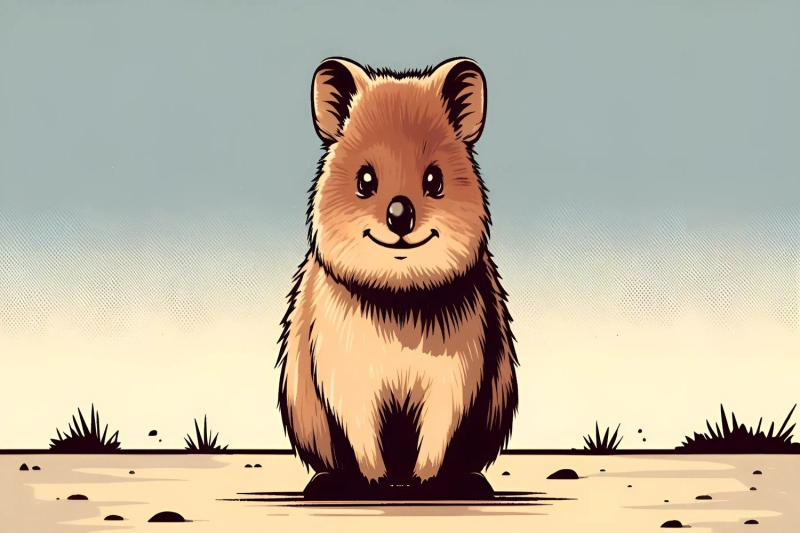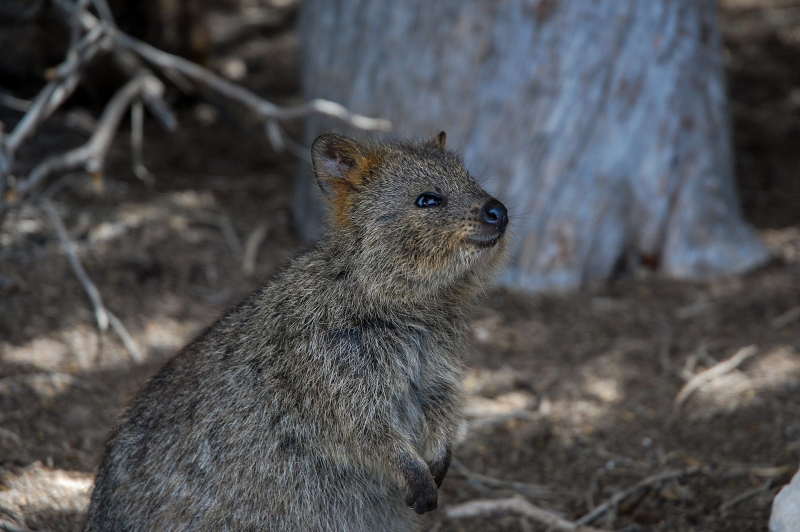
© Image generated by DALL-E AI for Presse-Citron
The quokka (Setonix brachyurus) is small (about 40 to 54 cm long) and its weight varies between 2.5 and 5 kg. With its small size, its frankly cute face and characteristic crooked smile, the quokka has conquered the hearts of millions of Internet users. He even became a viral selfie star on social media with the hashtag #quokkaselfie on Instagram, boasting over 50,000 posts!
Yet the lives of these web stars remain unknown to the general public while their population is rapidly declining. Here's what you need to know about these animals nicknamed the ” happiest animals in the world ” and on the efforts of scientists to preserve their smiles.

© Ena Music/Wikipedia
Rottnest Island: a tourist but fragile sanctuary
Nestled off the coast of Perth, in the west of Australia, Rottnest Island attracts crowds with its heavenly beaches and peaceful atmosphere. But what also makes it unique is its population of quokkas. Indeed, the island is home to around 10,000 individuals, the majority of the world's population of quokkas and offers an idyllic setting for observing these docile creatures accustomed to human presence.
Their curious nature and infectious smile make them perfect subjects for memorable selfies, which is why the quokka has gained so much popularity. However, Larisa DeSantis, a vertebrate paleontologist at Vanderbilt University who studies quokkas, cautions against this excessive comparison. “ It's best to avoid getting too close to them ” she explains.
She also recalls that the quokka, despite its apparent sympathy, remains a wild animal. « It is often unknown that quokkas can bite […] It is possible to’ get a nice photo with a quokka without encroaching on its living space ”.
Unfortunately, his notoriety on social networks is not without shadows. A popular meme, circulating since 2018, conveys an erroneous and cruel image of this animal. This meme claims that adult quokkas do not hesitate to sacrifice their young in the face of predators to save their own skin from danger.
Although this statement is obviously exaggerated and does not reflect reality, it is inspired by behavior observed in certain marsupials. Indeed, when faced with imminent danger, the female quokka can actually relax her pouch and drop her young to the ground. This strategy, documented in this study, although risky, aims to distract the predator and give the mother time to escape.
An endangered habitat and a future threatened
Previously, the quokka occupied a much larger territory in western Australia. Currently, its habitat is limited to a handful of islands and restricted areas of the dense forests of the southwest of the Australian continent. According to expert estimates, there are only 15,000 quokkas left in the wild. They are therefore classified in the category of vulnerable species and on the red list of the IUCN (International Union for Conservation of Nature).
Lara DeSantis expresses her concern about the quokka situation: “ Habitat fragmentation is a chronic problem. Add to this the invasive species and now climate change with increasingly violent fires ”. Continental Australia has almost completely seen these marsupials disappear, with the latter preferring to take refuge in forest areas which provide them with shelter and food.
A situation which, according to Lara DeSantis, would have already started with the colonization of Australia in the 19th and 20th centuries, the European arrivals who brought with them invasive species which have greatly weakened local ecosystems. Quokkas fell victim to this phenomenon, leading to a drastic decline in their population.
Subscribe to Lemon Squeezer
Better understand quokkas to better save them
Research led by Lara DeSantis and her team at Vanderbilt University revealed an unknown aspect of the history of these animals. Published in 2020 in the Journal of Zoology, they revealed that quokkas occupied much more diverse habitats for millennia, described as “mosaics”. ;”. Work is underway which opens up new perspectives for the conservation of these little critters.
« If we can reduce and eliminate foxes in these areas, which conservationists are actively working to do, we will no longer necessarily have to manage isolated populations in the most vulnerable areas. dense forests. Quokkas do perfectly well in these mosaic habitats ” explains the paleontologist.
These results suggest that the preservation of quokkas should not be limited to the protection of current dense forests. It must also focus on the restoration of more diverse habitats closer to their historic environment. These marsupials have demonstrated other more recent research, including one that focused on mapping their DNA in order to better understand how they adapt.
If the quokka attracts crowds with its contagious smile, its situation is very far from being idyllic. Victim, like many species in Australia, of the fragmentation of its habitat, predation by invasive species and climate change, this emblematic animal of the country has, for the moment, not a very happy future. This is why this research and the combined efforts of scientists and conservationists are essential: so that the quokka continues to smile for generations to come .
- The quokka is an Australian marsupial with an atypical appearance. His body shape is such that you can have the impression that he is smiling, which has made him a real star of social networks.
- Its habitat has been largely degraded since colonization in the 19th and 20th centuries, and its population is mainly concentrated on Rottnest Island.
- The scientific community continues to study it to understand how to better preserve it, the quokka being classified as a vulnerable species by the IUCN.
📍 To not miss any news from Presse-citron, follow us on Google News and WhatsApp .
[ ]

